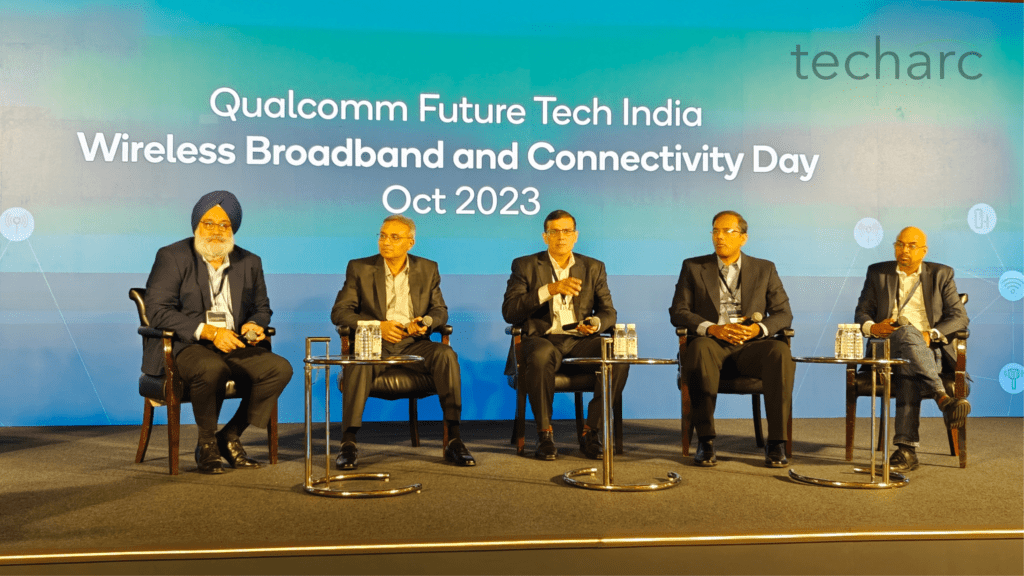Your cart is currently empty!
Qualcomm India held ‘Qualcomm Future Tech – India Wireless Broadband and Connectivity Day’ on Oct 12th in New Delhi. This was after a gap of several years that it organised an event like this. Such an event was held by the chipset maker before covid.

Back then it was all about smartphones. The event was attended by all key smartphone OEMs and the agenda was expanding 4G and a peep into what 5G has in store. At the yesterday’s event it was a lot more beyond smartphones. No doubt mobile remains the key revenue generator with close to 78% of its global revenues coming in from this category. But at the same time, like the entire ecosystem, Qualcomm is also widening its TAM as connectivity becomes all pervasive. Yesterday’s event was a glimpse of what is in store for Qualcomm beyond smartphones.
Qualcomm MSM and CDMA Days
The chipset major has come across a long way. My first exposure to the brand was back in 2006, when I was a researcher with my first analyst firm and things were completely different for the company. It was synonymous to CDMA and the world of mobile was divided into GSM and CDMA. The company would ship a little more than 250 million chipsets of what it was those days known as MSM or simply Mobile Station Modem.
Things got exciting in 2007, when the smartphone journey really kicked off with iPhone launch. Though for Qualcomm it would start a year earlier as the chipset industry has a lead time than the end products. 3G was in talks so were the early samples of Snapdragon being distributed to customers.
Smartphones and more
Since then, over these 16 years, Qualcomm became an important chipset provider for the mobile, especially smartphone industry. It also played a key role along with other industry partners in developing superior experiences for high compute use cases like gaming followed by adoption of AI. During this period, Qualcomm also attempted into laptops, however, that journey is yet to take off. Though a few OEMs did introduce snapdragon powered laptops, but it wasn’t that big. What surprises me still is why is Qualcomm away from Smart TVs? (Suggested read Techarc India Connected Consumer Report 2023)
Coming back to the event of Oct 12, 2023, Qualcomm had a lot more to discuss and share. Wi-Fi, telecom infrastructure, FWA and of course 5G were some of the flavours that were presented by the respective global leaders at Qualcomm signifying the importance of these elements in creating an experiential broadband in India irrespective of whether delivered wireless or through wire.
Priorities for India
Talking of the key priorities for India, Savi Soin SVP and President Qualcomm, the recently appointed India chief outlined areas including automotive, IOT, digital transformation including Private 5G, 5G acceleration and deeper integration with the government and allied ecosystem to further push marquee initiatives like Make in India and Design in India, as well as see how it can play a pivotal role in schemes like PLI and DLI.
We are already aware of some of the announcements in the auto sector in India from Qualcomm, and there are already IOT solutions available for consumers that are powered by their processors. On the 5G front, there are already smartphones available on Qualcomm platforms across price spectrum and with Snapdragon 4 Gen1, we have recently started to see its devices in the basic tier of the market as well. Some of these include Redmi Note 12 and iQOO Z6 Lite. Further Jio also announced at the event that its working with them on CPE and other gear based on the latest generations of various technologies around 5G and Wi-Fi. Similarly, its partnership with Jio for their FWA (JioAirFiber) was also made public.
The paradigm shift
To me it’s a paradigm shift in the industry. There was a disconnect, especially in the Indian market between the technology makers like Qualcomm and the operators. Same holds true about the CPE makers especially smartphone OEMs. But now things are changing and 5G is, I would say forcing all the partners to collaborate. This is the only way how things can be developed and co-created. There is a need to go for R&D and product development collaborations in the 5G era and beyond. Qualcomm-Jio is one such example and I see more of such collaborations coming up soon.
This is the only effective way of eliminating the bottlenecks. For instance, in Wi-Fi, there are already some of the products in the market, especially smartphones which are now Wi-Fi 7 enabled. But the routers / access points that are installed by the operators along with the provisioning of broadband in homes are mostly WiFi-5. The only option left with consumers is to buy latest specifications router from the open market which is an additional cost. In some cases, the operators also don’t make it easy for consumers to move on their router of choice. There are no direct ways but only hacks and tricks for which you need to be techy. Even then it will be sub-optimal.
While the technology providers like Qualcomm will also emphasise to leverage from the latest innovations across various wireless and wired technologies, the operator has a view of the customer and is constrained by quickly adopting them. Some of it is in the hands of an operator to change. For instance, it could offer a tier-based subscription plan for Wi-Fi which is not just determined by the speed and limit, and nowadays number of OTT apps bundled. Rather there is also an option for the customer to select the router and pay for Wi-Fi pro or premium, whatever the operator may want to call it.
But then this alone will not solve the challenge. The operator has a view of the customer and understands that the customer won’t just replace everything on to the latest Wi-Fi standards provisioned devices. For instance, Smart TV or laptop, which is anywhere 5 years plus investment in India and many other markets. So even if the bottleneck of router can be addressed, convincing customers to replace almost everything with the latest Wi-Fi standards is not feasible. So, what is the solution? No, no I don’t have it ready. But that is where the collaborations and deep integrations across the telecom value chain will do wonders. Together they should be able to find out a solution. May one of the ways for the operator is to introduce tiered smart home solutions which could be classified into basic, premium and uber. The user not only gets the MBPS to GBPS upgrades but also a set of different devices to choose determined by the standards of technologies they are built upon. A further possible business model could be smart home as a service. May be sometime in future!
With the view showcased by Qualcomm yesterday, it has made a bold statement that it is now, what I would like to refer as Allcomm, a technology provider for all the communications. That’s the takeaway for me.




